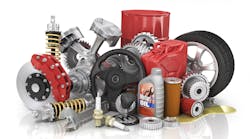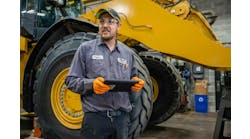Counterfeit products, produced to mislead customers, exist in numerous industries from clothing to entertainment to pharmaceuticals to automobile parts.
“What sets motor vehicle parts apart from other consumer products is the potential for catastrophic failure of counterfeit parts,” says Bill Hanvey, senior vice president of the Automotive Aftermarket Suppliers Association (AASA). “While it may be disappointing when a pirated DVD or CD fails to play or when a knockoff wristwatch falls apart, no lives are in danger. However, when a counterfeit part on a vehicle fails, it endangers everyone traveling our nation’s roads and highways.”
The AASA (www.aftermarketsuppliers.org) is the light vehicle aftermarket division of the Motor & Equipment Manufacturers Association (MEMA) (www.mema.org) and serves manufacturers of aftermarket components, tools and equipment and related products while providing a forum to address issues and serving as a resource for members.
“Combating counterfeits is a problem affecting many industries around the globe, and everyone – including distributors, national and local governments, business partners and customers – needs to be part of the solution,” say officials at General Motors (www.gm.com) – an American manufacturer of vehicles, parts and other automotive technologies.
WHAT IS A COUNTERFEIT PART?
A counterfeit product is any imitation of a manufacturer’s property, used without permission and intended to mislead consumers.
“The most valuable asset that a motor vehicle parts manufacturer has is its intellectual property – the processes the supplier uses to create, manufacture and market its products,” AASA’s Hanvey says. “Put simply, counterfeiting is the theft of this valuable asset.”
Counterfeiters tend to focus on the parts that are most often replaced. Consequently, says Hanvey, oil filters and brake components are the most frequently counterfeited items in the automotive sector.
“Brake related products seem to be the biggest area of concern,” agrees Tim Kraus, president and chief operating officer of the Heavy Duty Manufacturers Association (HDMA). “That has major safety and liability issues.”
HDMA (www.hdma.org) is the commercial vehicle division of MEMA and provides industry leadership for North American Free Trade Agreement (NAFTA) based original equipment and aftermarket suppliers in the on- and off-highway commercial vehicle equipment industry.
“Other counterfeit parts are seals, bearings, filters, lighting and a range of appearance products,” Kraus adds, noting that safety should be the primary concern regarding counterfeit items.
Hanvey warns that every component on a vehicle is subject to being counterfeited, referencing a shipment that was seized by federal agents in May at a Florida port. More than 3,200 counterfeit auto parts were found, ranging from automotive fuses to entire vehicle front ends.
He says other counterfeit parts seized by law enforcement include:
- Seat belts.
- Oil and air filters.
- Brake pads and rotors.
- Control arms.
- Windshields.
- Bearings.
- Steering linkages.
- Ignition coils.
- Microchips.
- Spark plugs.
- Wheels.
- Solenoids.
- Clutch housings.
- Crankshafts.
- Suspension parts.
- Oil pumps.
According to Kraus, counterfeit parts are more prevalent in the major metro areas in the northeast region of the country, as well as in Florida. Many of the complaints received regarding counterfeits stem from parts originating in Asia.
Kraus explains that counterfeiters work backward to mimic name-brand parts.
“Typically, a sample is obtained in the form of a physical product or engineering drawing,” says Kraus. “The next process would be to reverse engineer or copy the product design.”
The amount of time from when a supplier issues a new part to when a counterfeit may show up in the marketplace varies from category to category.
PROBLEMS CAUSED BY COUNTERFEIT PARTS
According to HDMA’s Kraus, many times a customer wants a low-priced product just to limp the vehicle by until it is sold or scrapped. However, turning to counterfeit or imitation parts can create costly problems as well as safety risks.
The global counterfeit problem is estimated at $600 billion per year, according to AASA’s Hanvey, citing the Federal Trade Commission (FTC) and the World Customs Organization in Interpol. “But the variety of counterfeited parts makes it difficult to put a price tag on the damage,” he says.
The damage to a reputable supplier’s brand and good reputation can be the most costly and the most difficult to quantify. “Counterfeiting can destroy a supplier’s good name and expose the company to potential product liability claims.”
Because of the numerous parts that can be counterfeit, the range of safety risks are abundant – i.e. faulty brakes that do not stop a vehicle, tires that shred or explode, rims that break, electrical components that short and spark engine fires, among many others.
“The risk is not just to the driver and passengers in the affected vehicle,” says Hanvey. “A car with any of these catastrophic failures is a danger to every vehicle around it on the road.”
These are not new dangers. It’s likely that counterfeit auto parts have been a part of the automotive industry since the first car rolled off the assembly line, says Hanvey. MEMA has existed for 111 years. In 2004, while the association was preparing for its 100th anniversary celebration, the group discovered 100-year-old pamphlets warning consumers and technicians about the dangers of “auto part piracy.”
As technology as advanced, counterfeiting abilities have expanded too. “There are a plethora of websites offering name brand auto parts at prices too good to be true,” Hanvey says.
HOW TO SPOT A COUNTERFEIT
Identifying a counterfeit part can be extremely difficult, according to AASA’s Hanvey. Even when comparing an imitation product side-by-side with a genuine one, it can be a challenge to identify differences.
“One important tip-off can be a bargain price from an unknown or unfamiliar seller,” he says. “Always keep the old adage in mind, ‘If a deal seems too good to be true, it usually is.’”
HDMA’s Kraus agrees that very low prices can be a clue that a part is not genuine. While some parts are nearly identical in appearance, there are signs that can indicate a product is fraudulent.
Hanvey says to examine the packaging and product closely. He says be wary of products:
- In packages, which have blurry or smeared logos.
- With faint or off-color logos or packaging.
- With logos in different locations than usual.
- That lack the trademark (™) or registration (®) marks.
- With misspellings in the package text.
HOW TO ENSURE THE USE OF GENUINE PARTS
According to Hanvey and the AASA, the best protection against counterfeit parts is to purchase trusted name brand parts from full-service aftermarket suppliers that stand behind their products. Parts can also be obtained from reliable trusted distributors and retailers – whether online or a brick and mortar storefront.
“Fleets should do business only with reputable repair shops, comparison shop and avoid deals that are too good to be true,” he says.
“Consumers should be vigilant in the marketplace and avoid counterfeit parts,” add GM officials. “They should purchase automotive parts only from authorized sources to ensure they’re getting genuine products. It’s only through the use of genuine parts that customers can be assured the parts will work properly in their vehicle.”
To be certain a parts source is reliable, HDMA’s Kraus says a fleet owner or shop manager can vet new suppliers by conducting performance tests on the product or by asking for a peer testimonial.
Additionally, fleet managers should stay informed about the sources of parts. The AASA Know Your Parts website is designed to raise awareness of the benefits of using premium parts.
Kraus says if a counterfeit part is realized, a fleet should “remove it immediately and engage the provider. The responsibility lies with them.”
“If you suspect you have inadvertently purchased counterfeit parts, consult a full-service supplier representative or a reputable technician for identification and replacement,” adds Hanvey.
Counterfeits can be reported online to U.S. Immigration and Customs Enforcement (ICE) (www.ice.gov) through the HSI (Homeland Security Investigations) tip form or by calling the tip line at 866-347-2423. Additionally, online complaints can be registered to the International Property Rights (IPR) center at www.iprcenter.gov.




